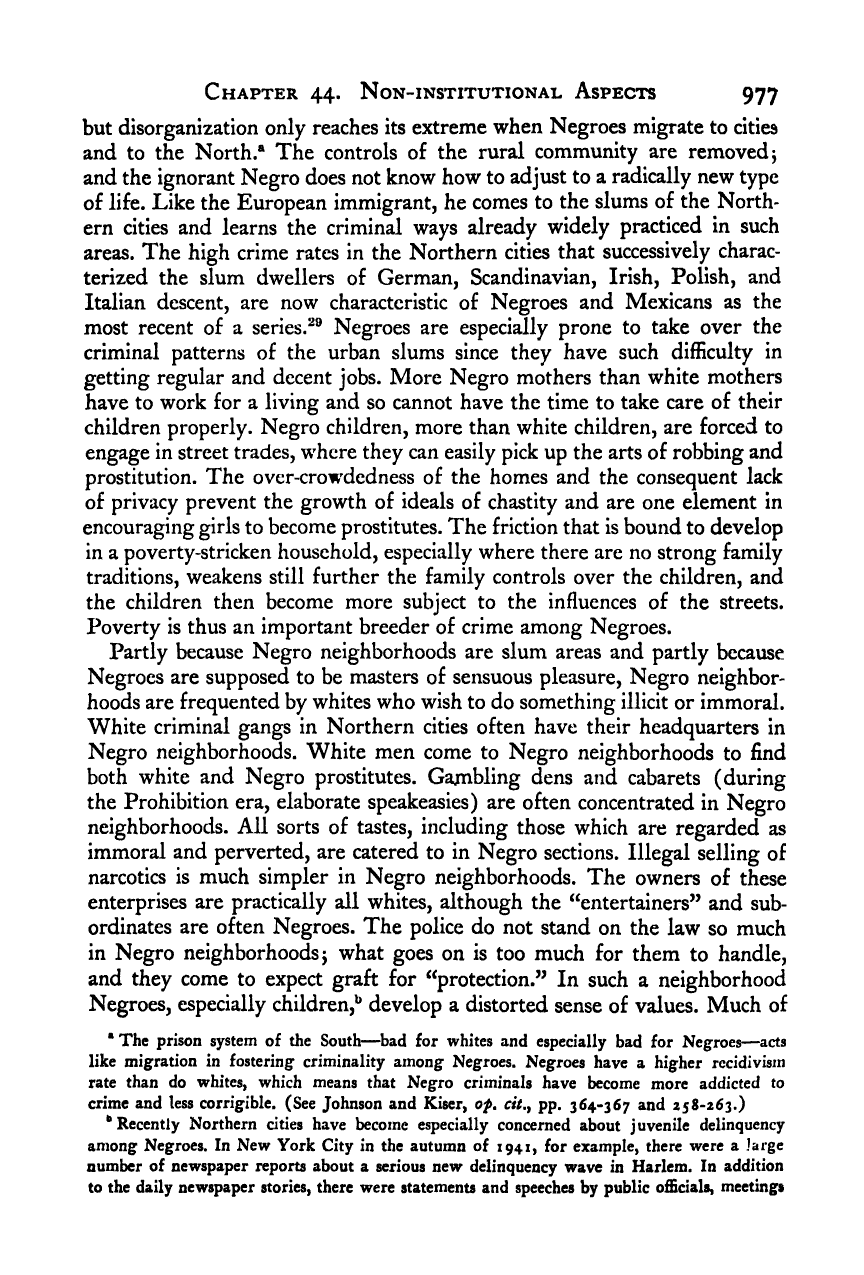Note: Gunnar Myrdal died in 1987, less than 70 years ago. Therefore, this work is protected by copyright, restricting your legal rights to reproduce it. However, you are welcome to view it on screen, as you do now. Read more about copyright.
Full resolution (TIFF) - On this page / på denna sida - X. The Negro Community - 44. Non-Institutional Aspects of the Negro Community - 2. Crime

<< prev. page << föreg. sida << >> nästa sida >> next page >>
Below is the raw OCR text
from the above scanned image.
Do you see an error? Proofread the page now!
Här nedan syns maskintolkade texten från faksimilbilden ovan.
Ser du något fel? Korrekturläs sidan nu!
This page has never been proofread. / Denna sida har aldrig korrekturlästs.
Chapter 44. Non-institutional Aspects 977
but disorganization only reaches its extreme when Negroes migrate to cities
and to the North.® The controls of the rural community are removed j
and the ignorant Negro does not know how to adjust to a radically new type
of life. Like the European immigrant, he comes to the slums of the North-
ern cities and learns the criminal ways already widely practiced in such
areas. The high crime rates in the Northern cities that successively charac-
terized the slum dwellers of German, Scandinavian, Irish, Polish, and
Italian descent, are now characteristic of Negroes and Mexicans as the
most recent of a series.^® Negroes are especially prone to take over the
criminal patterns of the urban slums since they have such difficulty in
getting regular and decent jobs. More Negro mothers than white mothers
have to work for a living and so cannot have the time to take care of their
children properly. Negro children, more than white children, are forced to
engage in street trades, where they can easily pick up the arts of robbing and
prostitution. The over-crowdedness of the homes and the consequent lack
of privacy prevent the growth of ideals of chastity and are one element in
encouraging girls to become prostitutes. The friction that is bound to develop
in a poverty-stricken household, especially where there are no strong family
traditions, weakens still further the family controls over the children, and
the children then become more subject to the influences of the streets.
Poverty is thus an important breeder of crime among Negroes.
Partly because Negro neighborhoods are slum areas and partly because
Negroes are supposed to be masters of sensuous pleasure, Negro neighbor-
hoods are frequented by whites who wish to do something illicit or immoral.
White criminal gangs in Northern cities often have their headquarters in
Negro neighborhoods. White men come to Negro neighborhoods to find
both white and Negro prostitutes. Gambling dens and cabarets (during
the Prohibition era, elaborate speakeasies) are often concentrated in Negro
neighborhoods. All sorts of tastes, including those which are regarded as
immoral and perverted, are catered to in Negro sections. Illegal selling of
narcotics is much simpler in Negro neighborhoods. The owners of these
enterprises are practically all whites, although the “entertainers” and sub-
ordinates are often Negroes. The police do not stand on the law so much
in Negro neighborhoods j
what goes on is too much for them to handle,
and they come to expect graft for “protection.” In such a neighborhood
Negroes, especially children,*" develop a distorted sense of values. Much of
• The prison system of the South—bad for whites and especially bad for Negroes—acts
like migration in fostering criminality among Negroes. Negroes have a higher recidivism
rate than do whites, which means that Negro criminals have become more addicted to
crime and less corrigible. (See Johnson and Kiser, op, cit,^ pp. 364-367 and 258-263.)
‘‘Recently Northern cities have become especially concerned about juvenile delinquency
among Negroes. In New York City in the autumn of 1941, for example, there were a large
number of newspaper reports about a serious new delinquency wave in Harlem. In addition
to the daily newspaper stories, there were statements and speeches by public officials, meetings
<< prev. page << föreg. sida << >> nästa sida >> next page >>